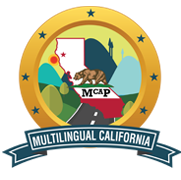
Traduzca esta página:
GOALS

The Multilingual California Project adopts the four goals defined in the project RFA. Additionally, to ensure sustainability of the project goals adds a fifth goal outlined below:
1. Build capacity among school leaders to implement the EL Roadmap Policy including implementation of culturally and linguistically responsive practices.
2. Support implementation of instructional practices that effectively develop academic content knowledge, discipline-specific practices, academic language, integrated and designated English language development, and multilingual and multiliterate proficiency.
1. Build capacity among school leaders to implement the EL Roadmap Policy including implementation of culturally and linguistically responsive practices.
2. Support implementation of instructional practices that effectively develop academic content knowledge, discipline-specific practices, academic language, integrated and designated English language development, and multilingual and multiliterate proficiency.
3. Identify and emphasize high-quality models for professional development regarding the EL Roadmap Policy, including, but not necessarily limited to, providing coaching for principals, teacher leadership opportunities, and the implementation of other models informed by research and best practices to best meet the needs of school leaders.
4. Support the implementation, alignment, and articulation of the EL Roadmap Policy across and within school district systems.
5. Create a multilingual collaborative statewide network of experts and agencies to guide systems that support the development of effective cross-curricular, disciplinary-based instructional practices for all English Learners.
Furthermore, the network experts will support, implement, and sustain the impact of the English Learner Roadmap, aligned with CA-SS and Quality Professional Learning Standards.
4. Support the implementation, alignment, and articulation of the EL Roadmap Policy across and within school district systems.
5. Create a multilingual collaborative statewide network of experts and agencies to guide systems that support the development of effective cross-curricular, disciplinary-based instructional practices for all English Learners.
Furthermore, the network experts will support, implement, and sustain the impact of the English Learner Roadmap, aligned with CA-SS and Quality Professional Learning Standards.
PROJECT DESIGN

The Multilingual California Project plan is designed to implement the project goals and build the capacity of LEAs to implement the California English Learner Roadmap. This plan is grounded in the Quality Professional Learning Standards, and utilizes an equity-centered, continuous improvement process called Liberatory Design.
The Liberatory Design Process emerged from Stanford University’s design thinking model, with important contributions from the National Equity Project, and guides participants to explore systemic inequities across curricular areas and within the English Learner Typologies (newcomer, progressing, with disabilities, LTELs, RFEP, language background, etc).
The Liberatory Design Process emerged from Stanford University’s design thinking model, with important contributions from the National Equity Project, and guides participants to explore systemic inequities across curricular areas and within the English Learner Typologies (newcomer, progressing, with disabilities, LTELs, RFEP, language background, etc).
Educators identify the throughline of their actions to English Learner outcomes, and through continuous improvement create transformational change. Teachers, paraprofessionals, principals, and district leaders will receive on-going, job-embedded guidance, professional learning and coaching through Liberatory Design, as they build their capacity to implement the English Learner Roadmap.
As they engage in this reflective practice, LEA’s will articulate their growth goals on living documents such as: LCAP, EL/Multiliteracy Masterplan, SPSA, WASC, etc.
As they engage in this reflective practice, LEA’s will articulate their growth goals on living documents such as: LCAP, EL/Multiliteracy Masterplan, SPSA, WASC, etc.
